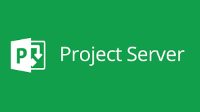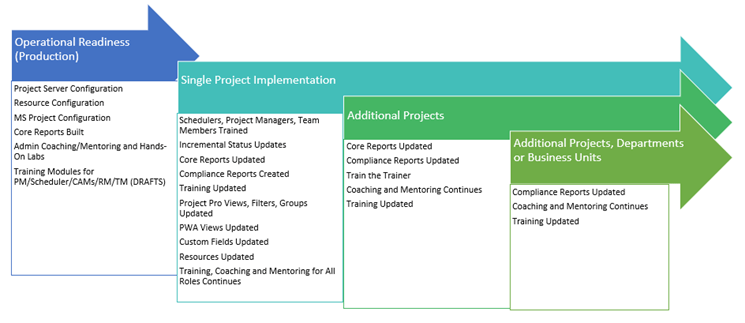 One of the biggest challenges I see at organizations revolve around Resource Capacity Planning. Whether it’s understanding their current capacity of skills, teams or departments or getting visibility into the demand of work in the upcoming months or year they all struggle. My best advice is to NOT do this on your own but get a partner that can work with you to build your roadmap, implement, configure Microsoft Project Server or Project Online, build your reports, train your resources and support you until your internal team is skilled to support the organization. To be truly successful a partner needs to be with you the whole way. If they say they can have you all set in 2 months then that’s not a partner, that’s an installer. Find a partner that will help you end to end; that has a methodology for project management and scheduling that they recommend with their Resource Capacity Planning Roadmap. If they don’t have anything they can discuss with you then find another partner. Too often I get into organizations where they’re on they’re 3rd or 4th try with Microsoft Project Server or Microsoft Project Online and they think it’s the tool or their culture and the truth is they’ve had the wrong partner. One of the biggest challenges I see at organizations revolve around Resource Capacity Planning. Whether it’s understanding their current capacity of skills, teams or departments or getting visibility into the demand of work in the upcoming months or year they all struggle. My best advice is to NOT do this on your own but get a partner that can work with you to build your roadmap, implement, configure Microsoft Project Server or Project Online, build your reports, train your resources and support you until your internal team is skilled to support the organization. To be truly successful a partner needs to be with you the whole way. If they say they can have you all set in 2 months then that’s not a partner, that’s an installer. Find a partner that will help you end to end; that has a methodology for project management and scheduling that they recommend with their Resource Capacity Planning Roadmap. If they don’t have anything they can discuss with you then find another partner. Too often I get into organizations where they’re on they’re 3rd or 4th try with Microsoft Project Server or Microsoft Project Online and they think it’s the tool or their culture and the truth is they’ve had the wrong partner.
What’s in a Roadmap? Here’s how a typical Roadmap engagement proceeds. First, we go onsite with a customer for about a 2 to 5 day assessment to review their current processes, tools, culture, communication styles, methodologies, challenges, people and skills, goals and leadership. After the assessment, we work closely with the customer to build an achievable Roadmap that blends our recommendations with the organizations strengths and weaknesses. The Roadmap deliverables include the current state, future state, GAP Analysis, recommended implementation approach, a high-level cost estimate and a set of Deliverable-Based Schedules for each portion of the Roadmap. In addition, we also add an important piece where we align the Business Objectives with the Features and Value of each. Here’s a sample for the Objective and Feature Alignment:
Once we get approval, we typically have multiple, parallel paths for the implementation (see below) and interesting enough, we use the Production Environment during ‘Operational Readiness’ for our own schedules, so the customer can see we don’t just implement but we also use our own tool. During this time, our customers really get a solid understanding as they shadow our team as we build the schedules, status the schedules, add and updated issues and risks and this all feeds into the automated status reports. If you missed that part, I meant to say ‘Automated Project and Portfolio Status Reports’! Of course, this is just our resources and PMO or EPMO resources but it’s ‘real’ data and the team can begin to tell a story from the data that they can then begin to show other Projects, Departments, Resource Managers or teams. It’s impressive that we can have some data with value within just a few weeks.
Here’s some key areas you should expect as a part of your Roadmap and Implementation. Feel free to use this for bidding your RFP or when you work with us. The Roadmap
Operational Readiness
Internal Review Many of the concepts, processes and reports that we talk about at the beginning of the POC will take some time to understand and how to implement within your organization. We recommend a few weeks to absorb it and work on the first implementation. Here’s some of the deliverables during the review.
Single Project Implementation Many organizations have the misconception that the implementation is a massive endeavor and it can be if someone lets you go down this path. I don’t recommend this approach as the project managers/schedulers need time to learn the tool and processes. There’s a lot of benefits to using Microsoft Project Server or Project Online but the Project Managers must have a solid understanding of how it will work. Here’s some of the pieces for the first implementation by role:
Iterative Implementations
These continue until you have enough projects and resources in the system that you can begin to conduct ‘what if’ scenarios and conduct more advance Portfolio and Resource Capacity Planning.
As you can see, there is a lot to Resource Capacity Planning but the benefits of time, money, proactive decision making and increased confidence in the PMO are priceless. Hopefully, you see the value in Microsoft Project Server or Project Online and start your Roadmap soon. Let us know if we can help. |
| ||||||
Author Profile

Latest Entries
 PMO RoadmapsOctober 3, 2025Resource Manager Benefits with Project Server
PMO RoadmapsOctober 3, 2025Resource Manager Benefits with Project Server PMO RoadmapsOctober 2, 2025Benefits of Project Server for Project Managers
PMO RoadmapsOctober 2, 2025Benefits of Project Server for Project Managers ConsultingMay 21, 2024Startup Recommendations: Why Use Microsoft Project Online and Office 365
ConsultingMay 21, 2024Startup Recommendations: Why Use Microsoft Project Online and Office 365 Project OnlineApril 2, 2024The Ultimate Guide: Benefits of Microsoft Project Online for Finance
Project OnlineApril 2, 2024The Ultimate Guide: Benefits of Microsoft Project Online for Finance









 Ask your partner if they plan to use your environment for their project schedule so you can track their progress and earned value without having to ask questions or wait for status meetings. If they don’t plan to use it….find a different partner!
Ask your partner if they plan to use your environment for their project schedule so you can track their progress and earned value without having to ask questions or wait for status meetings. If they don’t plan to use it….find a different partner!